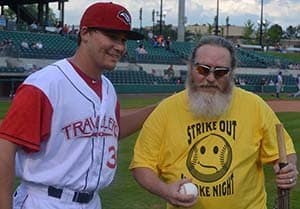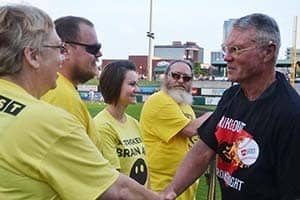Survivors Throw Strikes Against Stroke

Arkansas Travelers player Mark Shannon greets stroke survivor John Glidewell during Strike Out Stroke on May 14 at Dickey-Stephens Park.
| May 19, 2015 | FAST-acting medical attention culminated in some fast balls thrown from the pitcher’s mound by stroke survivors at Strike Out Stroke Night events in Dickey-Stephens Park in North Little Rock and Arvest Park in Springdale.
Remembering the FAST acronym — Face, Arm, Speech and Time — is central to recognizing the stroke symptoms of facial drooping or an uneven smile, arm numbness or weakness, and slurred speech or difficulty speaking or understanding speech, and then getting timely treatment for the patient.
Five survivors threw their strikes against stroke May 14 at the AR SAVES Strike Out Stroke Night during a pregame ceremony at Dickey-Stephens Park at an Arkansas Travelers game against the Tulsa Drillers.
On April 15, survivors did the same at Arvest Park in Springdale before a game pitting the Northwest Arkansas Naturals against the Midland, Texas Rockhounds – both games featuring teams from Minor League Baseball’s Class AA Texas League.

Stroke survivor George Crocker, right, shakes hands with the four other survivors Marcia Griffith, left, Dustin Martinez, Ticia Covington and John Glidewell.
“Strike Out Stroke events are big successes across Arkansas,” said Michael Manley, director of the Arkansas Stroke Assistance through Virtual Emergency Support (AR SAVES). “They are done at the local community level, and our cooperative efforts working with the Arkansas Travelers and the Northwest Arkansas Naturals are important to reaching a wide audience about the signs and symptoms of stroke.”
An Air Evac Lifeteam helicopter delivered the baseballs at Arvest and Dickey-Stephens parks for the survivors to use.
Volunteers from AR SAVES sites around the state worked at stroke education booths at the ballparks to distribute informational materials and answer questions. Brain-shaped stress toys were thrown into the stands.
The AR SAVES program is a partnership between the UAMS Center for Distance Health, the state Department of Human Services and 47 Arkansas hospitals.
The program uses a high-speed video communications system to help provide immediate, life-saving treatments to stroke patients 24 hours a day. The real-time video communication enables a stroke neurologist to evaluate whether emergency room physicians should use t-PA, a powerful blood-clot dissolving agent, within the critical three-hour period following the first signs of stroke.
Arkansas, which ranks first in the nation in stroke death rates, had 1,560 stroke-related deaths in 2011, according to the national Centers for Disease Control and Prevention. Since the program began Nov. 1, 2008, more than 2,791 patients have received stroke consults through AR SAVES and 751 patients have received t-PA.

Stroke survivors Peggy Holland, left, and Jerry Holland, right, at Arvest Park in Springdale on April 15 get ready to throw strikes against stroke. Peggy Holland’s son, Arkansas state Sen. Bruce Holland, center, accompanied his mother.
“Both Strike Out Stroke events really allow us to deliver our message about stroke to much greater numbers of people in a fun, different way,” Manley said. “Not only do we reach the fans that are there, but also those who listen by radio as well as the news coverage we receive.”
He said that by using a mix of media and events to reach the public, AR SAVES is helping people learn how to recognize stroke symptoms.
“It’s priceless and a real home run for our program and the people we serve.”